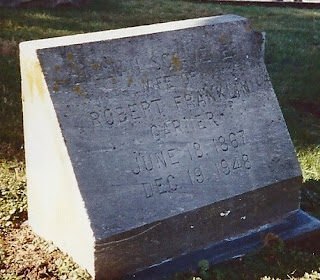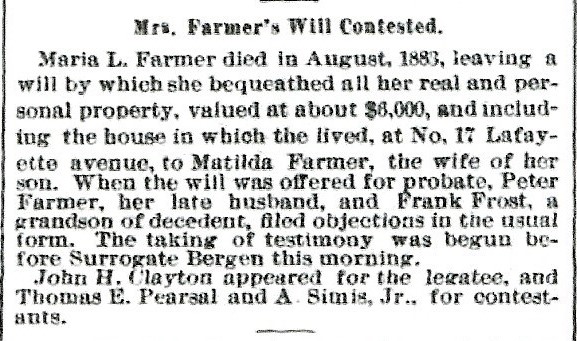I have two photographs of my paternal 2X-great-grandmother, Sallie Barber Scrivener. Both of them show her as a wizened little old lady.
In the photo at the left, which I date at about 1905, Sallie is shown at her home in Anne Arundel County with three of her five sons and three of her five daughters and three of her six grandchildren.
I have always been sorry that I know so little about Sallie and have no pictures of her as a younger woman or child. I know the basic facts about her life: birth, marriage, death, but really nothing of her as a person. I wish I had been able to meet her and know her better. She shouldn't be remembered as just a wizened little old lady. She had a life.
Sallie was born 25 November 1835 at her father's plantation, Silverstone, in Calvert County MD, very close to the border with Anne Arundel County. Sarah Jane Kent Barber was the second child and oldest daughter of Jonathan Yates Barber (named for his grandfather, Major Jonathan Yates of the Revolutionary War) and Mary Wheeler Kent. She had three brothers and three sisters. Her three sisters were more than ten years younger than Sally, the youngest being born after she had married and left the house, so she probably was not very close to them. As the oldest daughter, I imagine she was expected to take on a lot of responsibility for helping to run the household. I wonder how she felt about that? Was she a tomboy who would rather hang out with her brothers? Did she have a favorite doll? Did she enjoy gardening? Did she like to ride horses? Was she a born organizer?
 |
| Jonathan Yates Barber |
Sallie's life at Silverstone was probably a comfortable one. Her father was a well-to-do slave owner with large land holdings. Her mother was politically well-connected, being the daughter of State Senator Daniel Kent and the niece of
Governor Joseph Kent. Were there parties? Did Sallie like to dance? Did she like music? Did Sallie have any interest in politics?
Her older brother, Philip Daniel Barber (1833-1882) was a physician practicing in Calvert County. He was educated at Dickinson College in Pennsylvania. He married Sarah Priscilla Allnutt in 1875 and had six children with her, although only one lived to adulthood.
Her brother Jonathan Yates Kent Barber (1840-1893) was a farmer in Calvert County. He married Jane Garner in 1867 and had three children with her, one of whom lived to adulthood.
Her brother, Thomas Kent Barber (1841-1924) was also a physician, practicing in Baltimore County. He graduated from the University of Maryland in 1865 and married Harriet Geneva (MNU) shortly after. They had two daughters.
Her sister, Mary E. Barber (1845-1922), married Dr. John Sparrow Smith in 1884. The couple was childless.
Her sister, Margaretta Kent Barber (1850-1924) remained unmarried, living with her widowed sister Mary in Chesapeake Beach.
Her youngest sister, Lydia Chaplen Billingsley Barber (1858-1936), married farmer John G. Mattox in 1895.
Education had some value in the Barber family since two of the sons went to college. What was Sallie's education like? Could she read and write? Did she like to read? If so, what were her favorites? Did she ever wish she could go to college? Or would she have been shocked at the idea?
Sallie married William Boswell Scrivener, an Anne Arundel County farmer, in 1856 at her father's plantation when she was 21 years old, and William was 28. William had purchased Holly Hill, a well-known estate dating back to the 1600's, in anticipation of the marriage. Sallie and William called the place Rose Valley and raised ten children there. Was Sallie a good cook? Did she have a special recipe?
 |
| Rose Valley/Holly Hill |
Like the Barbers, William and Sallie attended All Saints Church in nearby Sunderland, Calvert County. In 1867, their four oldest children were baptized at the family home with their Barber grandparents as sponsors.
Sally and William rode out the Civil War at Rose Valley, although William never served in either army during the conflict. (The surgeon who examined Union draftees, being a Southern sympathizer, routinely excused men from service, including William and his brothers Samuel and James. Many of those who weren't excused from service were listed as "skedaddled South.")
The 1860 Census shows William as the owner of 17 slaves ranging in age from six months to 50 years old. His real estate was valued at $25,500 and his personal estate at $11,000. Besides his wife and 2 children, William also had a farm manager and his family living with him in 1860.
Anne Arundel County, like much of Southern Maryland, definitely had Confederate sympathies. As soon as the southern states seceded, President Lincoln ordered federal troops into Maryland, and for most of the Civil War, Anne Arundel County was under military occupation. (Lincoln, by the way, got exactly 3 votes from Anne Arundel County in the election of 1860, and I'm quite sure William was not one of them.)
By 1870, the couple had seven children, and the Census values William's real estate at $10,000 and his personal estate at $3000, the loss in value undoubtedly due to the emancipation of his slaves. In an 1876 tax assessment, William's 460-acre property was valued at $9200, with the buildings valued at an additional $2000. He was also taxed for $20 worth of silver, 6 horses, 21 cattle, 3 mules, 29 sheep, 24 hogs, and 1 carriage and buggy. So, the family was still fairly well-off.
Both of Sallie's parents died in 1877 and were buried at All Saints Church, Sunderland.
The 1880 census shows William and Sallie living with ten children at their farm, ranging in age from 3 to 22. Four of the children--Sallie, Leila, Kate and Fred--were shown as attending school. William was the trustee for a primary school in the neighborhood, and the children seemed to have gotten an education up to the 8th grade, judging by their later census records. That must have been a lively household. What kind of entertainments did the family have when they weren't busy with farm chores and homework?
 |
| William Boswell Scrivener |
Sallie was widowed in 1895 at the age of 60 when William Boswell Scrivener died after a fall from his horse. He was buried at All Saints Church in Sunderland, a few miles from his home in Friendship. How did Sallie cope?
The inventory of William's estate indicates a modest lifestyle with simple furnishings. A coal stove and two wood stoves provided heat, and oil lamps provided light. A washing machine with a wringer was used for laundry.
I wonder if Sallie had some special memento or family heirloom that she treasured. Were there any other family photographs is what I would really like to know and where did they go? Did that portrait of her father hang in the house? I have always wondered how it got passed down.
In 1896, three of William's properties were put up for sale so that his estate could be distributed: 250 acres lying directly on Herring Bay, described as "the best farm in the state for club or sporting purposes," including two tenant houses and a granary; a 45-acre property, half of which was covered in timber; and his home farm consisting of 150 acres plus a large brick dwelling, stables and other outbuildings.
The home farm at Rose Valley was purchased by the family and remained in the family until it was sold in 1937.
Sallie and William had ten children, five sons and five daughters. Like her parents, Sallie favored using family names (Wheeler, Kent, Barber, Boswell, Yates) for their children, connecting them to their heritage. Though I wonder if girl's names like Kate Estelle and Lillian Eliza were borrowed from some romantic novel. I haven't seen those names in the family earlier.
Mary Wheeler Kent Scrivener (1857-1942) never married and lived with her mother and various of her siblings until her death.
William Boswell Scrivener Jr. (1858-1928) never married and worked on the family farm until his death.
Sarah Jane Barber Scrivener (1862-1945) married George Bourne Gantt in 1897 and had two children with him: Sally and George.
Leila Mary Scrivener (1864-1942) married Howe Somervell Allnutt in 1891 and had two sons with him: Howe Somervell Jr. and John James.
.jpg) |
| Frank P. Scrivener Sr. |
Frank Phillip Scrivener (1865-1936), my great-grandfather, worked as an accountant for the Gottshalk company in Baltimore. He married Louise Gwynn Scrivener in 1899 and had one son: Frank Phillip Scrivener Jr. Frank attended Glenwood Academy and seemed to be the only one of his siblings who went beyond an 8th-grade education. I speculate that his name, by the way, was also based on family--Francis Scrivener and Phillip Barber, his great-grandfathers.
Kate Estelle Scrivener (1866-1918) married Harry Weems Wilkinson in 1905. They had one child who died in infancy.
 |
| Jonathan Y. Scrivener |
Frederick William Scrivener (1870-1959) married Annie Elizabeth Vaughn in 1903. They had one daughter, Camilla, who died in infancy. Fred managed the family farm.
Jonathan Yates Kent Scrivener (1874-1957) married Jean Francis Mackintosh in 1902 and was later divorced, which I am sure was a scandal at the time. This is the only one of my great-aunts/uncles that I ever knew personally, and I remember him visiting our family as an old man. (Although he was younger than I am now, so I should be more careful about who I am calling old!) He worked as a travelling salesman.
William Kent Scrivener (1877-1941) known as Kent to distinguish him from William Jr. above, never married. He lived in Baltimore and worked as a travelling salesman.
Sallie Barber Scrivener died in Baltimore at the home of her daughter Leila Allnutt 4 September 1911 at the age of 75. Her death certificate indicates that she died from atherosclerosis, exacerbated by debility from a fall. She was buried besides her husband and several of her children at All Saints.
I so wish that Sallie had left a diary or letters or that her children had passed on more information about their mother's personality. I would love to know how she felt about the events that shaped her life. She lived through a major war that upended her life. She raised ten children. I am sure that she had feelings and insights about the events and people around her that I will never get to know, and that is a loss I feel keenly.
This is one of the reasons that I try so hard to pass along family stories and whatever details I have about my ancestors so that they are not just known by the bare facts of their existence but have some personality in the imaginations of their descendants.


.jpg)















































